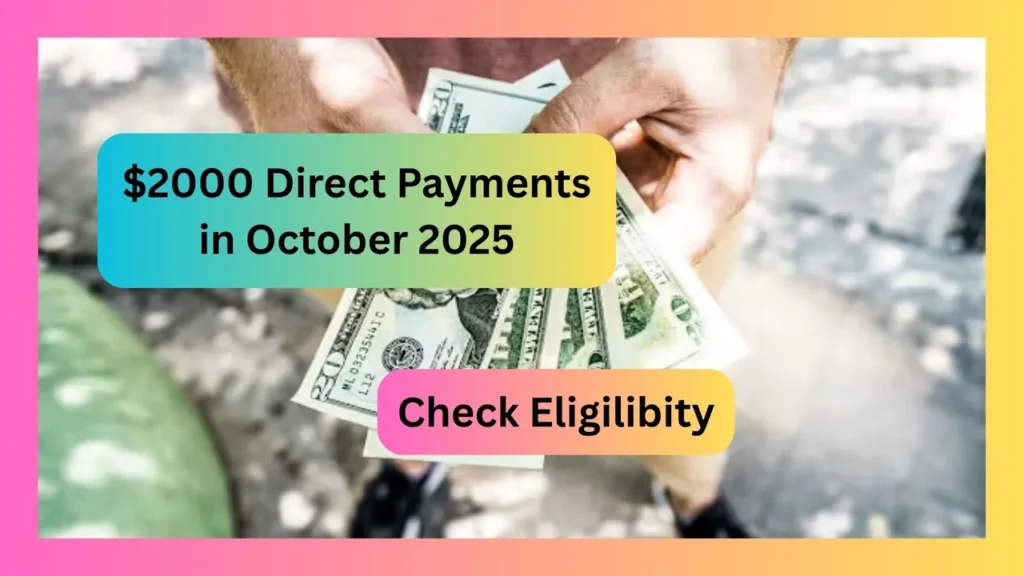Have you heard the buzz about the upcoming $2000 direct payments in October 2025? If you’re wondering whether this is real, who qualifies, and how you can claim it, you’re not alone. With so much confusion and misinformation spreading online, it’s important to break things down clearly. Let’s explore what these payments are all about, what you should expect, and whether you might benefit from them.

What Are $2000 Direct Payments?
The $2000 direct payments are financial relief checks expected to be issued in October 2025. They’re designed to help individuals and families facing economic pressures, rising costs, and ongoing inflation challenges. In short, think of it as a financial cushion from the government to ease the burden of everyday expenses.
Why Are These Payments Happening Now?
So, why October 2025? Timing is key here. Governments usually roll out direct payments during times of economic uncertainty, high inflation, or when public support is needed most. With food prices, housing, and medical costs continuing to climb, October’s relief payments are meant to give families a much-needed breather.
Who Qualifies for the $2000 Payments?
Not everyone will qualify for these checks. Typically, eligibility is based on income levels, filing status, and sometimes even dependents. While exact guidelines may vary depending on federal or state programs, the payments usually prioritize low to middle-income households who need support the most.
Income Limits You Should Know
One of the most asked questions is, “How much income is too much to qualify?” While details for October 2025 are still being finalized, past direct payment programs usually capped eligibility around:
- $75,000 for single filers
- $150,000 for joint filers
- Reduced payments for higher income brackets
How Will the Payments Be Sent?
Here’s the good news: if you qualified for earlier stimulus checks, the process will feel familiar. Payments are generally delivered by direct deposit, mailed checks, or prepaid debit cards. If your tax info is up to date, you won’t have to lift a finger—your payment will come automatically.
Do You Need to Apply?
This is another common question. In most cases, you won’t need to apply. However, if you haven’t filed taxes recently or your information is outdated, you may need to submit updated details to the IRS or state agencies to ensure you don’t miss out.
What Can You Use the $2000 For?
There are no strings attached to these payments. You can use them for anything you need—groceries, rent, bills, healthcare, or even savings. Think of it as your money to spend in the way that makes the most sense for your household.
How Does This Compare to Previous Payments?
Remember the stimulus checks during the pandemic? This October payment feels similar but with one key difference—it’s being issued in response to ongoing inflation and cost-of-living concerns rather than a national emergency. Still, the impact could be just as big for families struggling to keep up.
The Economic Impact of Direct Payments
Direct payments don’t just help individuals—they also boost the economy. When people have extra money, they spend it on goods and services, which in turn supports businesses and jobs. It’s like throwing a pebble into a pond—the ripple effect spreads outward.
Common Misconceptions About the $2000 Payments
Let’s clear the air on a few myths:
- Myth 1: Everyone in the U.S. gets the payment automatically.
- Myth 2: You need to pay back the money later.
- Myth 3: Only unemployed individuals qualify.
In reality, eligibility depends on income and filing status, payments are not loans, and both employed and unemployed individuals may qualify.
When Exactly Will the Payments Arrive?
While October 2025 is the official month, the exact date may vary. Some people could see direct deposits hit their bank accounts early in the month, while others may need to wait a bit longer for mailed checks. Patience is key here.
What If You Don’t Receive Your Payment?
Mistakes happen—bank errors, outdated tax information, or wrong addresses can cause delays. If you don’t see your payment, you may need to contact the IRS or relevant state agency. Keeping your information updated is the best way to avoid hiccups.
How to Prepare Now
Want to make sure you’re ready? Here are a few quick steps:
- File your taxes on time
- Update your bank details with the IRS
- Keep an eye out for official announcements
Doing these now can save you the stress of wondering whether your payment will arrive.
Should You Count on This Payment?
Here’s the tough truth: while $2000 can make a big difference, it’s not a long-term solution. Treat it as a short-term relief, not a permanent fix. Budget wisely and plan how you’ll use the money in advance so it stretches further.
Final Thoughts
The $2000 direct payments in October 2025 are more than just financial relief—they represent hope for families feeling the squeeze of rising costs. While the details are still rolling out, preparing now ensures you won’t miss your opportunity. Stay informed, keep your information updated, and when that money lands in your account, use it wisely.
FAQs
1. Who is eligible for the $2000 direct payments?
Eligibility is usually based on income levels, filing status, and tax records. Low to middle-income households are most likely to qualify.
2. Do I have to apply to get the payment?
In most cases, no. Payments are typically sent automatically if your tax information is up to date.
3. Will I need to pay taxes on the $2000 payment?
Most direct payments are considered tax-free, but it’s always best to check official IRS guidelines.
4. Can I get the payment if I don’t have a bank account?
Yes, you may receive a paper check or prepaid debit card if direct deposit isn’t an option.
5. When should I expect to see the $2000 in my account?
Payments are scheduled for October 2025, but the exact arrival date may vary depending on your payment method.